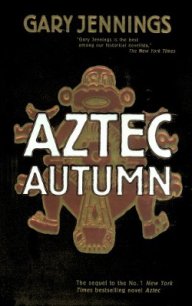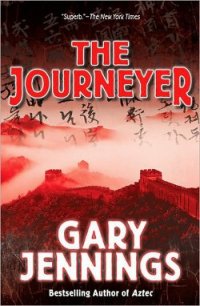Aztec - Jennings Gary (электронные книги без регистрации txt) 📗
Presumably Cortes, by means of messengers, directed the general strategy of his several officers and their detachments, but he—and Malintzin—remained in the luxurious residence of the Texcoco palace in which I myself had once lived, and he kept the hapless Revered Speaker Cohuanacoch there too, as his compulsory host, or guest, or prisoner. For I should mention here that the Crown Prince Black Flower, who had grown old waiting to become Uey-Tlatoani of the Acolhua, never did get that title and that eminence.
Even after the taking of the Acolhua's capital city, in which Black Flower's troops had played no small part, Cortes decreed that the inoffensive and uncontroversial Cohuanacoch should remain on the throne. Cortes knew that all the Acolhua, except those warriors who had for so long followed Black Flower, had come to loathe the once-respected Crown Prince as a traitor to his own people and a tool of the white men. Cortes would not risk provoking a future uprising of the whole nation by giving the traitor the throne for which he had turned traitor. Even when Black Flower groveled in the rite of baptism, with Cortes for his godfather, and in flagrant obsequiousness took the Christian name of Fernando Cortes Ixtlil-Xochitl, his godfather unbent in his resolve only sufficiently to appoint him lord ruler of three insignificant provinces of the Acolhua lands. At that, Don Fernando Black Flower showed one last flicker of his former lordly temperament, protesting angrily:
"You give me what already belongs to me? What has always belonged to my forefathers?"
But he did not long have to endure his dissatisfaction and debasement. He stormed out of Texcoco to take up his rule in one of those backwoods provinces, and arrived there just when the disease of the small pocks was also arriving, and within a month or two he was dead.
We soon learned that the marauding armies' Captain-General was lingering in Texcoco for other reasons than merely to enjoy a rest in luxury. Our quimichime came to Tenochtitlan to report, not more mystification, but the news that the departed half of Cortes's force was returning to Texcoco, bringing on their backs or hauling on log rollers the many and various hulls and poles and other components of the thirteen "ships" that had been partially constructed on the dry land of Texcala. Cortes had stayed to be in Texcoco when they arrived, to oversee their assembly and launching upon the lake there.
They were not, of course, any such formidable things as the seagoing ships from which they had been fashioned. They were more like our flat-bottomed freight barges, only with high sides, and with the winglike sails that, we discovered to our dismay, made them far more swift than our many-oared biggest aciltin, and far more agile than our smallest. Besides the boatmen who controlled the vessels' movements, each carried twenty Spanish soldiers who stood on shelves behind those high sides. Thus they had the significant advantage of holding the height in any water battle with our low-slung canoes, and even stood high enough to discharge their weapons across our causeways.
On the day they made their trial voyage from Texcoco into the lake, Cortes himself was aboard the leading craft, which he called La Capitana. A number of our largest war canoes rowed out from Tenochtitlan and through the Great Dike, to engage them in the most open expanse of the lake. Each canoe carried sixty warriors, each of whom was armed with a bow and many arrows, an atlatl and several javelins. But on the choppy waters, the white men's heavier craft made much more stable platforms from which to discharge projectiles, so their harquebuses and crossbows were lethally more accurate than our men's hand-held bows. Besides, their soldiers had to expose only their heads and arms and weapons, so our arrows either struck in their boats' high sides or went harmlessly over them. But our men in the low, open canoes were exposed to the darts and metal pellets, and many of them fell dead or wounded. So the canoes' steersmen desperately tried to keep at a safer range, and that meant a distance too great for our warriors to fling their javelins. Before very long, all our war canoes came ignominiously home, and the enemy craft disdained to pursue them. For a while they almost gaily danced in intricate crossings and patterns, as if to show they owned the lake, before going back to Texcoco. But they were out again the next day, and every day after that, and they did more than dance.
By then, Cortes's under-officers and their various companies had marched all the way around the lake district, laying waste or capturing and occupying every community in their path, until at that time they had reassembled in two sizable armies, positioned on the headlands jutting into the lake exactly north and south of our island. It only remained for them to destroy or subdue the larger and more numerous cities situated around the lake's western shore, and they would have Tenochtitlan completely surrounded.
They went about it almost leisurely. While the other half of Cortes's army was resting in Texcoco, after its incredible labor of transporting those battle boats overland, the boats themselves went back and forth over the entire expanse of Lake Texcoco east of the Great Dike, clearing it of every other craft. They rammed and overturned, or they seized and captured, or they killed the occupants of every single canoe that plied the waters. And those were not war canoes: they were the acaltin of everyday fishermen and fowlers and freighters peaceably carrying goods from one place to another. Very soon, the winged battle boats did own all that end of the lake. Not a fisherman dared to put out from shore, even to net a meal for his own family. Only at our end of the lake, inside the dike, could the normal water traffic continue, and that did not continue for long.
Cortes finally moved his resting reserve army out of Texcoco, dividing it into two equal parts which separately made their way around the lake to join the other two forces poised north and south of us. And while that was being done, the battle boats breached the Great Dike. Their soldiers had only to sweep the length of it with their harquebuses and crossbows, and kill or rout all the unarmed dike workers who could have closed the flood-protection gates to impede them. Then the boats slid through those passages and were in Mexica waters. Though Cuautemoc immediately sent warriors to stand shoulder to shoulder along the northern and southern causeways, they could not long repel the advance of the boats, which headed directly for the causeways' canoe passages. While some of the white soldiers cleared away the defenders with their hail of metal pellets and crossbow darts, other soldiers leaned over the boats' sides to pry loose and topple into the water the wooden bridges that spanned those gaps. So the battle boats got past the last barriers, and inside them, and, as they had done in the outer reaches of the lake, they cleared this end too of all water traffic: war canoes, freight acaltin, everything.
"The white men command all the causeways and the waterways as well," said the Snake Woman. "When they besiege the other cities on the mainland, we have no way of sending our men to reinforce those cities. What is worse, we have no way of getting anything from the mainland. No additional forces, no additional weapons. And no food."
"There is enough in the island storehouses to sustain us for some while," said Cuautemoc, adding bitterly: "We can thank the small pocks that there are fewer people to be fed than there might have been. And we have also the chinampa crops."
The Snake Woman said, "The storehouses contain only dried maize, and the chinampa are planted only with delicacies. Tomatoes and chilis and coriander and the like. It will be a quaint diet—poor men's tortillas and mush, garnished with elegant condiments."




